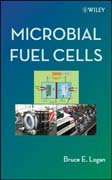
INDICE: 1. Introduction.1.1. Energy needs.1.2. Energy and the challenge ofglobal climate change.1.3. Bioelectricity generation using a microbial fuel cell.1.4. MFCs and energy sustainability of the water infrastructure.1.5. MFC technologies for wastewater treatment.1.6. Renewable energy generation using MFCs.1.7. Other applications of MFC technologies.2. Exoelectrogens.2.1. Introduction.2.2. Mechanisms of electron transfer.2.3. MFC studies using known exoelectrogenic strains.2.4. Community analysis.2.5. MFCs as tools for studying exoelectrogens.3. Voltage generation.3.1. Voltage and current.3.2. Maximum voltagesbased on thermodynamic relationships.3.3. Anode potentials and enzyme potentials.3.4. Role of enzymes versus communities in setting anode potentials.3.5. Voltage generation by fermentative bacteria?4. Power generation.4.1. Calculating power.4.2. Coulombic and energy efficiency.4.3. Polarization and power density curves.4.4. Measuring internal resistance.4.5. Chemical and electrochemicalanalysis of reactors.5. Materials.5.1. Finding low-cost, highly efficient materials.5.2. Anode materials.5.3. Membranes and separators (and chemical transport through them).5.4. Cathode materials.5.5. Long term stability of differentmaterials.6. Architecture.6.1. General requirements.6.2. Air-cathode MFCs.6.3. Aqueous cathodes using dissolved oxygen.6.4. Two chamber reactors with soluble catholytes or poised potentials.6.5. Tubular packed bed reactors.6.6. Stacked MFCs.6.7. Metal catholytes.6.8. Biohydrogen MFCs.6.9. Towards a scaleable MFC architecture.7. Kinetics and Mass transfer.7.1. Kinetic or mass transfer models?7.2. Boundaries on rate constants and bacterial characteristics.7.3. Maximum power from a monolayer of bacteria.7.4. Maximum rate of mass transfer to abiofilm.7.5. Mass transfer per reactor volume.8. MECs for hydrogen production.8.1. Principle of operation.8.2. BEAMR systems.8.3. Hydrogen yields and energy balances.8.4. Hydrogen recovery.8.5. Energy recovery.8.6. Hydrogen losses.8.7. Differences between the BEAMR and MFC systems.9. MFCs for WWT.9.1. Process trains for WWTPs.9.2. Replacement of the biological treatment reactor with an MFC.9.3. Energy balances for WWTPs.9.4. Implications for reduced sludge generation.9.5. Nutrient removal.9.6. Electrogenesis versus methanogensis.10. Other Technologies.10.1. Different applications for MFC-based technologies.10.2. Sediment MFCs.10.3. Enhanced sediment MFCs.10.4. Bioremediation using MFC technologies.11. Fun!11.1 MFCs for new scientists and inventors.11.2 Choosing your inoculum and media.11.3 MFC materials: electrodes and membranes.11.4 MFC architectures that are easy to build.11.5 Operation and assessment.12. Outlook.12.1 MFCs yesterday and today.12.2 Challenges for bringing MFCs to commercialization.12.3 Accomplishments and outlook.Appendix: Notation.
- ISBN: 978-0-470-23948-3
- Editorial: John Wiley & Sons
- Encuadernacion: Cartoné
- Páginas: 216
- Fecha Publicación: 01/02/2008
- Nº Volúmenes: 1
- Idioma: Inglés
